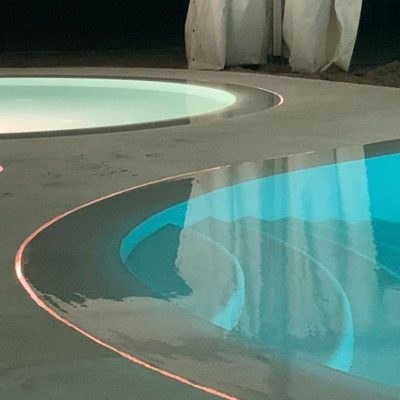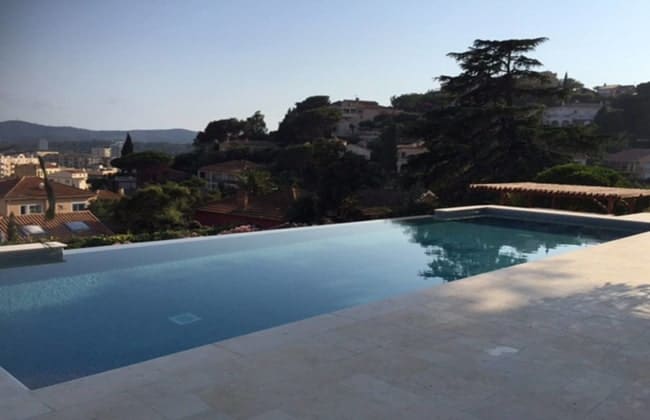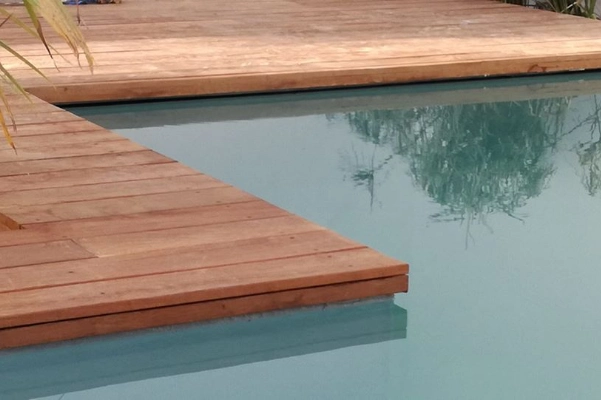Zero edge pool or negative edge pool ?
The question often comes at a crucial moment — when the view is in place, the lines of the house are drawn, and it’s time to shape the water.
You want silence. Elegance. A pool that reflects the sky without interrupting the scene. But do you want the water to vanish into the horizon? Or to sit flush with the terrace, still as a mirror?
While both are overflow systems, their visual language couldn’t be more different. One amplifies the landscape. The other disappears into it.
Let’s break down the difference — not just technically, but emotionally. Because choosing an overflow is never just about hydraulics. It’s about how you want the space to feel.
Overflow pools don’t just look different — they operate differently too.
Unlike skimmer pools, which draw water through isolated openings, overflow systems let water flow continuously over the edge into a concealed gutter, allowing for cleaner surfaces and smoother hydraulics.
👉 Curious about the full construction method? Explore our Infinity Pool Construction Guide.
The Different Types of Overflow Pool Designs
Most of the pollution is found on the entire surface of the pools and spas: dust, pollen, dead insects, hair, and sun oil, among others.
The skimmers are the only openings to suck up the surface water and send it to the filtration system. A 10 × 5 regular swimming pool means a maximum suction length of 1 meter (2 skimmers).
Let’s consider the same pool with a weir over a length. The skimming of the surface water is multiplied by ten, and the impurities floating have no time to settle onto the bottom. Imagine then the performance of a zero-edge swimming pool!
That’s why, for the same pump flow rate, the filtration of the overflow swimming pool is much more efficient. The homeowners find the maintenance much more manageable.
What’s The Difference Between A Zero-Edge Pool And An infinity edge pool
Overflows can take various forms. As each responds to a different aesthetic need, it is necessary to choose not only based on one’s personal preference, but also based on the property’s requirements.

Zero-edge pool with LED slot overflow detail – Morana Water Design
The zero-edge pool or perimeter overflow
Among the most refined types of overflow, the zero-edge pool offers both stillness and sophistication.
Often chosen for urban patios or spa areas, it creates a seamless visual flow.
A pool that blends silence, geometry and light. Its surface stays flat as glass — no splash, no gutter in sight.
With its resolutely contemporary design, it is one of our favorites. It seems to “sit” on the landscape like a “mirror.” It is of great elegance and exudes a very calm atmosphere.
Perfectly silent, the water overflows into the perimeter lower gutter covered by a grate, often in public swimming pools. However, a slot in the terrace lining frequently replaces this ugly grating (see the photo). The water reaches the gutter and then the catch basin. This second version is undoubtedly much more aesthetic.
Contrary to popular belief, this deck-level pool is not limited to rectangular pools.
Create slightly inverted slopes to avoid mixing rainwater with the pool water.
In conclusion, you can build a zero-edge pool in patios, flat spaces between buildings, or on the ground without any particular view. And remember, it can be adapted to all pool shapes, geometric or free form.
💡 Also known as a perimeter overflow pool, this design is widely used in luxury hotels due to its flawless water level and invisible gutter.
When the knife edge detail is applied to a zero-edge design, the result is often referred to as a Lautner edge pool — a more demanding and exclusive version of the system.”
The infinity or negative edge swimming pool
It is undoubtedly best known because it has a significant aesthetic impact. It reveals all its beauty on the ground with a slope, but it can create a beautiful effect on almost flat land.
Only one side of the pool is lower than the deck level. From the house or the deck, it feels as though the water disappears into nature. Of course, it’s only an illusion. It is, of course, a visual effect. If they swim towards the edge, they’ll meet a solid wall.
Making the gutter invisible from the house’s terrace is imperative to achieve such an overflow. Otherwise, you will lose that impression of extension to the horizon! Silence depends on the precision of the wall’s profile. If it’s poorly designed, the soothing murmur turns into a relentless roar.
And don’t forget that a sea view is not essential for such an overflow.

Let’s design the right overflow system — together.
Morana's advice 👇
There’s no single answer — only the right balance between slope, architecture and the feeling you want to create.
Whether you’re drawn to the silent elegance of a zero-edge pool or the drama of a vanishing horizon, we’ll help you define what suits your site and your vision.
And because perfection lies in the details, we’ll ensure your overflow system is precisely designed—from hydraulic balance to piping layout.
You bring the vision
We bring the precision.
The pool with overflow under coping
It is the oldest system and is now used very rarely. It can still be seen in old swimming pools in some countries, such as Morocco, Tunisia. Indeed, it was essentially built to allow the best skimming of the water surface.
Far less spectacular than other types of overflow, this system is now mostly reserved for specific uses, such as pool renovation or indoor pools. The water is, of course, not thrown down the drain but sent to the catch basin.

These pools were often built without a balancing tank. The legend running about the high water consumption of overflow pools comes probably from there. Click here if you want information on how the balancing tanks work in the overflow pools.
Combining overflow systems: Zero-edge meets negative-edge
After presenting the three main types of overflow — under-coping, negative edge, and zero-edge — a question often arises:
Can we combine multiple overflow systems within a single pool?
The answer is yes — and the result can be striking.
The most elegant combination blends a negative-edge overflow, which draws the eye toward the landscape, with a zero-edge perimeter that creates a tranquil, mirror-like surface around the rest of the pool.
This hybrid design offers the best of both worlds: a dramatic focal point and a refined, calming atmosphere.
Zero-Edge vs Negative-Edge Pools: Key Differences at a Glance
| Feature | Zero-Edge Pool | Negative Edge Pool |
|---|---|---|
| Overflow direction | All four sides (perimeter) | One side only |
| Visual effect | Mirror-like, reflective surface | Water disappears into the horizon |
| Best suited for | Flat sites, patios, enclosed areas | Sloped sites with open views |
| Architectural impact | Minimalist, symmetrical | Dramatic, directional |
| Sound | Silent (if well balanced) | Silent or waterfall effect depending on design |
| Maintenance | Requires precise levelling and slot design | Requires invisible gutter and accurate wall profile |
| Technical complexity | High (balancing tank, slot overflow, tight tolerances) | Moderate to high (wall shape and hydraulic balance) |
Frequently Asked Questions About Zero-Edge and Infinity Pools
Here are some of the most common questions we receive about the design, cost and installation of zero-edge and infinity pools.
How is a zero-edge or infinity pool built?
Both are in-ground structures built from reinforced concrete or modular systems such as shotcrete, poured concrete or shuttering blocks. Some manufacturers supply prefabricated shells or kits, and with detailed execution drawings self-build can be an option.
How much does a zero-edge pool cost?
Costs depend on design complexity, site conditions and equipment quality. Because zero-edge pools require a balancing tank, finely tuned hydraulics and very tight tolerances, a reliable budget is only possible after a detailed project study.
Can I install a zero-edge pool indoors?
Yes—provided the technical design addresses ventilation, humidity control and structural waterproofing. The layout must suit the interior while maintaining stable overflow performance.
Can an automatic cover be fitted to an overflow pool?
Yes. Covers can be integrated into zero-edge or infinity pools using submerged rollers, concealed compartments or bench systems. Early coordination with specialist suppliers ensures precise alignment and a discreet result.
Is a zero-edge pool really silent — even with wind or rain?
Yes—if the system is properly balanced. When engineered correctly, water vanishes into the slot without trickling or splash, producing a glass-flat surface and a calm acoustic environment.
Can I enjoy a vanishing-edge pool if I don’t have a sea view?
Absolutely. A negative-edge pool can frame any outlook—garden, hillside or vineyard—by positioning the weir to draw the eye towards the most open or attractive part of the landscape.
Conclusion
Choosing between a zero-edge and a negative-edge pool comes down to your intention and the character of your site.
Each design responds to a specific atmosphere, technical configuration, and architectural ambition.
Before shaping a bespoke project, we study the terrain, perspectives and surroundings to recommend the best solution.
